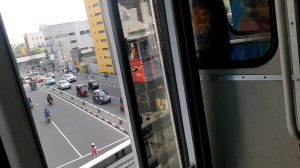Next stop: the Anti-Filariasis and Anti-Malaria Unit! Time to start finding my way around. Something that fascinates me when I travel is seeing how local transport systems work. It might sound far removed from medicine, but commuting is something that almost every person does on a daily basis. It’s also necessary for patients accessing medical services, and may be limited by poverty, disability, or other factors. Is transport affordable for all, or do those without good jobs have to walk? Could I get to the hospital on crutches, or in a wheelchair? Do people wear seatbelts here? I love trying to break down a new environment and try to figure out how it interacts with the wellbeing of its people. I always insist that I want to work directly with patients, and I get chills when I realise there’s a public health passion in there somewhere beckoning me to the dark side of academia. Horrifying.
Buses are cheap, move quickly, and don’t seem to come to a complete stop. I’m mastering the run-and-jump technique. They’re reliable, though, and I never have to wait more than a few minutes. Tuktuks are the next step up, costing about five times as much but still only a few NZD. They’re primarily booked through smartphone apps now, which provide a degree of safety as they immediately show you if your driver alters the route. I’m told cars are heavily taxed and expensive, but people who can afford them feel they’re safer than other options. I wouldn’t be able to drive here; the rules are different and demand an adrenaline-fueled mindset, and I’m quite impressed with the drivers’ skills. Come rush hour, the roads are chaotic and filled with motorbikes, pedestrians, and animal-drawn carts, and vehicles tend to switch lanes first and indicate later. As a pedestrian it can be tough to get out of the way of it all if you aren’t paying attention – I wonder about motor vehicle accidents (MVAs), and remind myself to keep my eyes peeled on the road.
After taking the wrong bus twice, no thanks to Google Maps, I was soon back en route to the Unit. I arrived just in time for a nurse-led teaching clinic being provided for patients with lymphoedema (limb swelling due to a blockage of lymph channels). The nurses explained how to bathe and care for the swollen limbs, as bacterial and fungal infections are a major risk. I watched them elevate, wrap, and massage the legs of an elderly lady with highly oedematous legs to encourage their drainage, and took some notes myself side by side with the patients. In the past, these patients would mostly be suffering from lymphatic filariasis. This awful disease is caused by repeated bites from mosquitos, which transmit microscopic roundworms that grow to block and damage the lymphatic drainage of the body. Most horrifically, this lockage goes on to cause elephantiasis, or immense swelling of affected areas that is often very disabling, stigmatising, and psychologically devastating. I was reassured by the local staff that this usually takes an extended period of repeated bites, and that I should be more concerned about dengue. I resolved to find a way to ‘number 8 wire’ my mosquito net that night, regardless.
Nowadays, Sri Lanka has mostly eliminated lymphatic filariasis. Cases still happen though, and so the clinic takes people who come in with any aetiology, with perhaps one in five patients parasitized and the rest affected due to a traumatic accident or poor outcomes from reconstructive surgeries. I met the resident doctor running the clinic, who let me sit in and go through his patients’ files. In Sri Lanka, patients bring their own files to the doctor, and the clinic has developed their own elaborate patient cards specifically for monitoring lymphoedema progression and cause. I’m struck by the poverty some patients seem to be in. Parasites preferentially prey on the weak and impoverished, and filariasis is no exception. The doctor told me that many of the patients travelled for kilometres to get to the clinic, sometimes despite extensive remodelling of their feet and legs. Once lymphoedema develops, people may be unable to work, worsening their plight. I’m beginning to realise how in Sri Lanka, improvements in parasitological medicine are crucial to reducing the impacts of the inequity these patients face.
After the clinic, I was led upstairs to the entomology lab. A roomful of people was peering intently at Mansoniamosquitos through microscopes, the variety responsible for transmitting lymphatic filariasis in Sri Lanka. They pulled up a seat for me and gave me a fresh specimen, and so began my comedy show. I’ve never dissected flies under a microscope – I didn’t even know that was something people did – so trying to wield two miniature chopstick blades and carefully remove individual feelers looked a lot like a toddler bashing the triangle block into the square hole and not understanding why it doesn’t work. After a long while, I managed to lop the little gremlin’s head off and proudly presented the staff my carefully segmented fly. Exasperated, they looked around and explained that I had spectacularly failed. So it turns out, the purpose of the task is to open up each body cavity and look for the filarial worms to see if the mosquitos are infected, so that locations where these mosquitos were collected can be identified and targeted for fumigation. I had successfully managed to examine none such cavities. Well, I never said I wanted to be a clinical entomologist anyway. I mashed up the poor thing but didn’t find any worms. Diagnosis: Unclear, correlate clinically.
I still hadn’t seen the Anti-Malaria section of the unit, but it was already time to go. I made plans to come back and organised to take leave for another day.






No comments yet.
Leave a comment